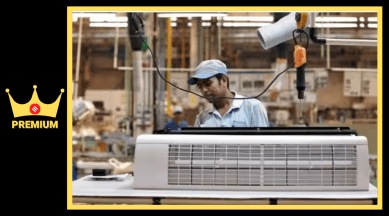From less than 1% to over 75%, how inverter ACs are catalysing the energy-efficiency revolution
"Inverter ACs are a preferable choice over the non-inverter ACs due to their low operational costs, increased energy efficiency, noiseless operation and maximum usage security," said Naohiko Hosokawa, Director & Business Unit Head- Living Environment Division, Mitsubishi Electric India.

Cost efficiencies, growing climate awareness and rising purchasing power is triggering a discernable consumption shift in India, with energy-efficient inverter air conditioners gaining traction among consumers and manufacturers ramping up output, India’s largest AC companies told The Indian Express. The increasing demand has given an impetus to domestic manufacturing, thereby lowering import dependency and sharply bringing down costs.
According to latest data from the Bureau of Energy Efficiency (BEE), Ministry of Power, inverter ACs accounted for less than 1 per cent of the overall room AC (RAC) market of 4.7 million units in the financial year 2015-16 (FY16). As of FY23, the share has increased to 77 per cent, while the fixed-speed RACs went down to 23 per cent.
The consumers’ push for an upgrade is visible across segments. “Along with the push towards premiumisation across categories, people want to buy the latest RACs, which run for 12 hours plus while saving on electricity. Some people are looking for WiFi ACs and seeing benefits,” said Shashi Arora, President, Blue Star.
LOWERING PRICES
While non-inverter ACs are fixed speed air conditioners where the compressor is turned on and off repeatedly. An inverter AC, on the other hand, is a variable speed AC where the compressor runs continuously, but way more efficiently and does the cooling job better while consuming less power. To meet the rising demand, the AC companies are stepping up with investments to set up manufacturing plants that produce higher end ACs in India.
Mitsubishi Electric India will set up a new manufacturing unit in Tamil Nadu’s Tiruvallur district at an investment of about Rs 1,891 crore. The production was expected to begin in 2025, and the initial capacity of RACs would be 3 lakh units and 6.50 lakh for compressors by December 2025. “The manufacturing cost has reached economy of scale and reduced; however, the
components and raw material cost has increased over the past few years, which has resulted in the stagnant overall product cost that is on the higher side itself,” Hosokawa said.
According to him, the combined cost of purchase and running of the inverter ACs is lower than that of the regular air conditioners regarding the upfront price versus the running cost trade-off. “Over the coming years, the cost of inverter air conditioners will definitely reduce, given that the key components and raw material should be indigenous,” he added.
Almost every Indian air conditioner manufacturing unit depends on the import of critical components and raw materials. However, as per the government norms, schemes such as Production-Linked Incentives (PLIs) have been introduced for implementation, which encourages AC manufacturers to invest in component manufacturing in India. For ACs, companies will be manufacturing copper tubing, compressors, control assemblies for IDU or ODU, Heat Exchangers and BLDC motors, among other components.
At present, Daikin, the world’s largest air conditioner manufacturer, builds around 15 lakh RAC units from its Neemrana facilities in Rajasthan, aiming for another 10-12 lakh units once the Sri City facility is set up by 2024.
“Most of the components for Daikin are imported from Thailand and Vietnam. Some components are already manufactured here in Neemrana. The prices of RAC will most likely go down once components are produced on a mass scale by next year,” a Daikin executive said, requesting anonymity.
BEE LABELING
The shift towards inverter ACs is a part of BEE’s India Cooling Action Plan, which was aimed to fulfil cooling demand, enhance energy efficiency and better technology options with a 20-year time horizon.
Explaining the benefit of BEE’s plan, Blue Star’s Arora said the biggest hurdle for consumers to buy RACs was monthly expenditure a decade ago. “Due to BEE’s star-rating system, the electricity cost went down considerably, about 65-75 per cent, leading to deeper penetration of ACs across the country,” Arora said. “The table for star-rating gets revised every two years. What was a 5-star RAC is a 4-star or 3-star now. As of 2023, no brand makes 5-star fixed RACs as it does not deliver energy efficiency,” he added.
In 2015, the bureau launched a voluntary labelling programme for inverter RACs and made the programme mandatory in January 2018. The labelling programme for RACs now covers fixed and inverter units under the same labelling scheme.
“The consumers are greatly aware of this concept, and the market demand is drifting towards the higher star-rated products, out of which 3-star-rated products are the biggest contributors,” said Mitsubishi Electric India’s Hosokawa, adding as Indian economy is growing well, it is supporting the consumers to opt for inverter air ACs that comes with a higher cost in the initial phase but saves on the price for longer time with reduced electricity bills and lesser maintenance requirements.